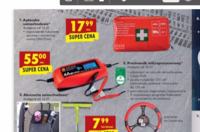Hi.
I am not an expert.
Miracles of invisibility are written in the instructions, but what is it really like?
The question is: with a microprocessor rectifier, eg Yato 8301 (8A), when charging a 60Ah battery, will it charge with a maximum current of 8A or will it choose the current depending on the voltage / capacity etc?
Most of the user manuals have tables.
For example, in Yato 8301:
8 A for battery capacity. 20 - 200 Ah
2 A for battery capacity. 5 - 40 Ah
I have a 60Ah battery, so looking at the table I have to choose the FAST (8A) option, the question is whether choosing 8A will not damage it, because it is more than 10% of the capacity ... Or maybe it is set to 8A, and he somehow selects it during charging (increases, decreases) => well finally there is a microprocessor, so I do not see a problem to give the perfect current depending on the capacity.
Thanks in advance.
I am not an expert.
Miracles of invisibility are written in the instructions, but what is it really like?
The question is: with a microprocessor rectifier, eg Yato 8301 (8A), when charging a 60Ah battery, will it charge with a maximum current of 8A or will it choose the current depending on the voltage / capacity etc?
Most of the user manuals have tables.
For example, in Yato 8301:
8 A for battery capacity. 20 - 200 Ah
2 A for battery capacity. 5 - 40 Ah
I have a 60Ah battery, so looking at the table I have to choose the FAST (8A) option, the question is whether choosing 8A will not damage it, because it is more than 10% of the capacity ... Or maybe it is set to 8A, and he somehow selects it during charging (increases, decreases) => well finally there is a microprocessor, so I do not see a problem to give the perfect current depending on the capacity.
Thanks in advance.




